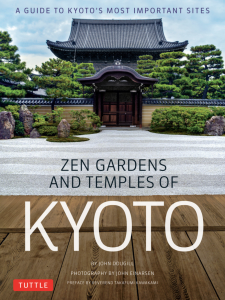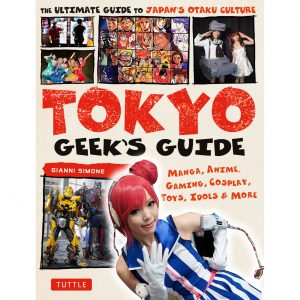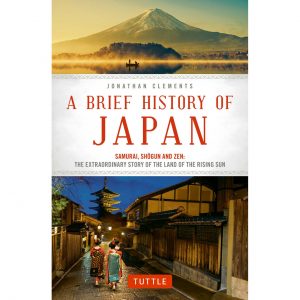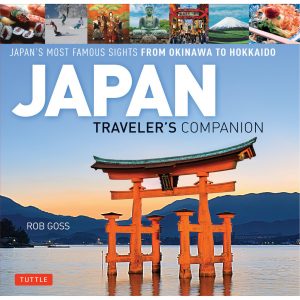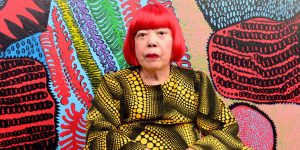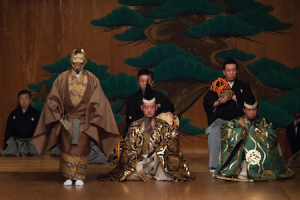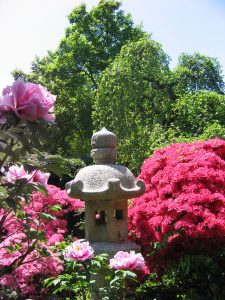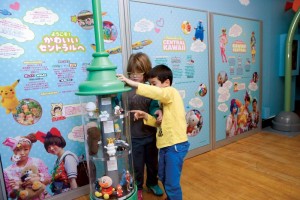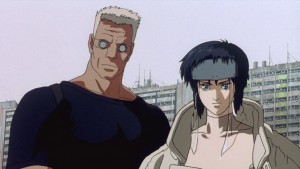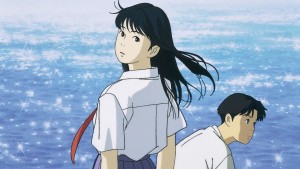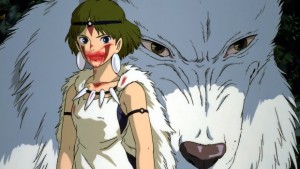JQ Magazine: Book Review — ‘Zen Gardens and Temples of Kyoto’
By Rashaad Jorden (Yamagata–ken, 2008-10) for JQ magazine. A former head of the JETAA Philadelphia Sub–Chapter, Rashaad is a graduate of Leeds Beckett University with a master’s degree in responsible tourism management. For more on his life abroad and enthusiasm for taiko drumming, visit his blog at www.gettingpounded.wordpress.com.
Kyoto has served as the focal point of Japanese cultural forms such as geisha, noh theater and ikebana. And as John Dougill thoroughly details in Zen Gardens and Temples of Kyoto, the city has played an enormous role in the development of Zen in Japan.
A professor at Kyoto’s largest Buddhist university, Dougill explores the ties between Japan’s former capital and the Buddhist sect in this guide to Kyoto’s most prominent Zen gardens and temple sites. While not the birthplace of Zen in Japan, Kyoto could be considered its soul as the city has long housed renowned temples where visitors and monks have sought serenity.
At first glance, such a book would seem to be a largely visual journal featuring a score of beautiful places. Zen Gardens doesn’t disappoint in that regard as photographer John Einarsen captures the splendor of some very spiritual places. But it’s clear early on that the book will rely primarily on stories to chronicle the story of Zen in Kyoto—not surprising since Dougill has previously written about Japan’s World Heritage Sites and Kyoto’s history.
JQ Magazine: Book Review — New from Tuttle (Fall 2017)
By Rashaad Jorden (Yamagata–ken, 2008-10) for JQ magazine. A former head of the JETAA Philadelphia Sub–Chapter, Rashaad is a graduate of Leeds Beckett University with a master’s degree in responsible tourism management. For more on his life abroad and enthusiasm for taiko drumming, visit his blog at www.gettingpounded.wordpress.com.
Tuttle Publishing has released a selection of four books touching on subjects such as otaku culture, language/cultural tips for travelers, Japanese history, and inspiration for prospective visitors to Japan.
Many people have probably developed an interest in Japan through a deep affection for anime and manga (among other things). And with Tokyo being the obvious center of Japanese pop culture, this guide created by Gianni Simone serves as the perfect tool for otaku freaks to find heaven.
Tokyo Geek’s Guide basically resembles a travel guide as it contains tidbits about where to explore otaku culture (such as bookshops, stores, events and even eateries—anime-themed ones are abundant in Tokyo). But you don’t have to be planning a trip to the capital to benefit from the book, though. Simone includes plenty of information pertaining to the history of manga, anime and video games in Japan.
Japanese for Travelers Phrasebook & Dictionary
At first glance, Scott Rutherford’s creation seems like a carbon copy of any other resource geared toward helping travelers avoid or limit communication miscues. And certainly, the book lists the standard customary helpful phrases for visitors to Japan trying to navigate the local hotels, airports, restaurants, etc.
But Japanese for Travelers provides plenty of useful advice about conducting good Japanese etiquette (e.g., what to do when invited to someone’s house) and culture (the section devoted to Japanese naming culture is interesting). Although the guide doesn’t intend to be the most thorough tool for language learners, it does include an English-Japanese glossary and numerous grammatical tips. And perhaps most importantly in this technologically reliant time, Rutherford dedicates a chapter to advising readers about how not to get tripped up by technology in Japan.
To many, the title of Jonathan Clements’s work would seem to be an absolute impossibility. Indeed, he uses that word in the preface to describe his task in telling a story that spans “millions of years.” But Clements settles on “specific moments of transformation” in eleven chapters that address periods of Japanese history ranging from the legend behind Japan’s formation to the “lost decades” that saw the country face a dwindling population and struggling economy.
While the information Clements provides at some points may be overwhelming, A Brief History of Japan does come to life through the collection of images appearing in the middle of the book (such as depictions of prominent figures and photos of landmarks).
Many, if not most, travel guides will feature an endless parade of “what to do and see” recommendations, and Rob Goss’s work is no different in a sense. But unlike some editions of Lonely Planet and Fodor’s, it’s clear when opening up Japan: Traveler’s Companion for the first time that the book will be anything but dry.
The subtitle appearing on its cover is “Japan’s most famous sights from Okinawa to Hokkaido,” but the inclusion of popular tourist destinations isn’t the reason to pick up the book. Amazingly beautiful colorful photos of the country’s most famous places will leave you speechless, and Goss includes helpful information for potential visitors about facets of Japanese life such as matsuri, cutting edge technology, and tradition.
For more information, visit www.tuttlepublishing.com.
For more JQ magazine book reviews, click here.
By JQ magazine editor Justin Tedaldi (CIR Kobe-shi, 2001-02). Justin has written about Japanese arts and entertainment for JETAA since 2005. For more of his articles, click here.
From the silver screen to the stage to J-pop, November is just as colorful as the autumn leaves drifting through the air. Add these live events to the mix and you’ve got an irresistibly epic rundown.
This month’s highlights include:
Now through Dec. 16
Yayoi Kusama: Festival of Life and Infinity Nets
David Zwirner Galleries, 525 and 533 West 19th Street and 34 East 69th Street
Free
Yayoi Kusama’s work has transcended some of the most important art movements of the second half of the twentieth century, including Pop Art and Minimalism. The exhibitions will feature sixty-six paintings from her iconic My Eternal Soul series, new large-scale flower sculptures, a polka-dotted environment, and two Infinity Mirror Rooms in the Chelsea locations, and a selection of new Infinity Nets paintings uptown. The celebrated Infinity Mirror Rooms invite the viewer to experience a sense of infinity through the play of reflections between the circular shapes of light and the surrounding mirrors. The Infinity Net paintings on view at the gallery’s uptown location are the latest works in a series begun in New York in the 1950s, when Abstract Expressionism was still the dominant style. These canvases embodied a radical departure, featuring minutely painted nets across monochrome backgrounds.
Nov. 3-5
Japan Society, 333 East 47th Street
$95, $75 Japan Society members, seniors and students (Nov. 4-5 only)
Part of Japan Society’s NOH-NOW series, celebrating its 110th anniversary! Hiroshi Sugimoto, acclaimed visual artist and traditional Japanese arts connoisseur, offers his most recent noh piece. In this new play, the ghost of revered 16th century tea master Sen-no-Rikyu appears to tell the story of his tragic death by forced suicide. Opening a door onto medieval Japan, the program begins with a tea ceremony by Sen So’oku, direct descendent of Sen-no-Rikyu, and features Japan’s top noh actors and musicians. Performed in Japanese with English titles.

Courtesy of Chopsticksny.com
Nov. 16-Dec. 3
SoHo Playhouse, 15 Vandam Street
$30
Universally funny and yet so very Japanese. Katsura Sunshine makes his highly-anticipated off-Broadway debut! As the world’s first bilingual rakugo-ka (a traditional Japanese comic storyteller), he is an international ambassador of this 400-year tradition. Fresh off 10 smash-hit performances in London’s West End, he will have a series of performances bringing his unique yet authentic rakugo to Off Broadway—in Japanese and English!
Nov. 17-19
Jacob K. Javits Convention Center, 655 West 34th Street
$35-$60; VIP passes also available
“Anime and manga have taken the world by storm. While New York City is the largest city in America, no focused event championing Japanese pop culture calls it home and with a population of eight million there’s a massive demand here,” says Peter Tatara, LeftField Media’s vice president of anime events. “Anime NYC will be a celebration of this community of fans and a platform for publishers and studios from both sides of the Pacific to be in front of the eyes of attendees, trendsetters, and people who aren’t yet familiar with the worlds of anime and manga. We’re looking forward to a vibrant, dedicated celebration of everything in Japan that’s nerdy and cool, in the media capital of the world!”
In this inaugural three-day celebration of Japanese animation powered by Crunchyroll, attendees will be able to view exclusive anime screenings and meet major guests courtesy of international animation and manga publishers; play the latest in Japanese gaming technology; chow down on Japanese delicacies and fusion cuisine; rock out to musical guests direct from Tokyo; and more! An estimated 20,000 fans are expected to attend, with special guests featuring the English-language cast of Sailor Moon Crystal for a panel screening; the U.S. premieres of the films Gundam Thunderbolt: Bandit Flower and Fullmetal Alchemist, and the NY Ramen Summit, featuring a discussion between famed ramen chefs from around the city.
JQ Magazine: New York Comic Con, ‘Porco Rosso,’ ‘The Legend of Zelda,’ Food Porn Party
By JQ magazine editor Justin Tedaldi (CIR Kobe–shi, 2001-02). Justin has written about Japanese arts and entertainment for JETAA since 2005. For more of his articles, click here.
The Japan-centric events of the month ahead promise to be as rich and full as autumn itself—brisk and colorful, with a dash of unpredictability.
This month’s highlights include:

Volume 1—FAIRY TAIL © Hiro MASHIMA / Kodansha Ltd.; Hiro Mashima—Photo courtesy of Kodansha Ltd.; Volume 61—FAIRY TAIL © Hiro MASHIMA / Kodansha Ltd.
Thursday, Oct. 5, 6:30 p.m.
Hiro Mashima: The Magical World of Fairy Tail
Japan Society, 333 East 47th Street
$30, $25 Japan Society members, seniors and students
Award-winning manga artist Hiro Mashima, known for his bestselling series Fairy Tail, comes to Japan Society for a special talk in conjunction with New York Comic Con. The epic fantasy series, which has sold over 60 million copies worldwide, follows the rambunctious wizard’s guild Fairy Tail through adventures in a stunning variety of settings, with a mind-boggling array of colorful characters. Mashima, also renowned for his long-running series Rave Master, joins us to discuss the works that have captured the imaginations of fans around the world. Moderated by Ben Applegate, director of the Kodansha Comics publishing team at Penguin Random House, and interpreted by Misaki Kido, marketing director at Kodansha Advanced Media. One lucky guest will win a surprise gift from Mashima-sensei at the event! Followed by a reception.
Oct. 5-8
Jacob K. Javits Convention Center, 655 West 34th Street
Limited tickets available
With a record attendance of more than 170,000 visitors last year, the East Coast’s biggest gathering for fans of comics, film, anime and manga, New York Comic Con returns with its biggest roster of Hollywood talent to date, and features exclusive screenings, gaming, cosplay photo ops, interactive booths by manga publishers including Vertical Comics and Kodansha Comics , and special guest appearances by manga artists Hiro Mashima (Fairy Tail) and Akira Himekawa (The Legend of Zelda)!
Friday, Oct. 6, 7:00 p.m.
Japan Society, 333 East 47th Street
$13, $10 seniors and students, $5 Japan Society members
Screening in 35mm! An ace fighter pilot and ex-member of the Italian Air Force during WWI is mysteriously cursed with a pig’s face. Disillusioned with humanity, he adopts the name Porco Rosso (“Crimson Pig”) and spends his time near the Adriatic Sea, drinking at a local bar and fighting off air pirates for cash. Famous for his unsurpassable flying skills, Porco draws the envy and antagonism of an American pilot who plots to take him down with the help of the fascist Italian police. This sixth film by Hayao Miyazaki is among the master animator’s most personal and underrated, highlighting his deep love for aviation and pacifist worldview within an action-adventure story perfect for adults and children alike.
Premieres Friday, Oct. 13
Metrograph, 7 Ludlow Street
$15
In her new documentary, Lana Wilson (After Tiller) takes us deep inside the life of another extreme altruist, Ittetsu Nemoto, a punk-rocker-turned-Buddhist priest who has worked small miracles in suicide prevention in his native Japan. Now facing the new challenge of fatherhood, as well as rapidly escalating health problems of his own, Nemoto must answer a crucial question—can he justify risking his own life to help others carry on with theirs? With astonishing access and artistry, The Departure captures one man’s wrenching decision between self-preservation and selflessness. Select screenings on Oct. 13 and 14 feature a special Q&A with the director.
Oct. 13-14, 7:30 p.m.
Japan Society, 333 East 47th Street
$35, $30 Japan Society members
Aesthetics of the past, present, East and West meld together in Italian director/choreographer Luca Veggetti’s Left–Right–Left, which explores the point of intersection between Japan’s 14th-century noh tradition and today’s efforts in dance. With leading Japanese butoh and contemporary dancers, esteemed noh musicians and a child noh actor reciting text from noh plays Okina and Hagoromo, this production offers a lens into the microcosm of humanity. Performed in English. The Oct. 13 performance is followed by a MetLife Meet–the–Artists Reception. The Oct. 14 performance is followed by an artist Q&A.
Oct. 13-14, 8:00 p.m.
92nd Street Y (Buttenwieser Hall), 1395 Lexington Avenue
$15-$29
Tap dancer Kazu Kumagai, known for his “powerful athletic technique combined with a riveting clarity” (2016 Bessie Outstanding Performer Award) channels his exceptional rhythmic artistry into the intensity of HEAR/HERE. The program includes a live jazz quartet and guest tappers, including legends Ted Louis Levy and Brenda Bufalino (2016 Bessie Award for Lifetime Achievement). This Dig Dance show is Kazu’s return to 92Y after a sell-out performance last season.
Wednesday, Oct. 18, 7:00 p.m.
The Nippon Club, 145 West 57th Street
$250, $200 members
A one-of-a-kind cultural experience! See Japanese Ozashiki culture in person with Geisha (Geiko and Maiko) from Nara, Japan. They will entertain visitors with their arts such as music, dance, conversations and traditional games while you enjoy Japanese food and sake. For RSVP and more info, call (212) 581-2223, or email info@nipponclub.org, attn: Mita, Uchikawa.
Friday, Oct. 20, 8:00 p.m.
The Legend of Zelda: Symphony of the Goddesses
United Palace Theater, 4140 Broadway
$28.13-$120
Back by popular demand and presented by Jason Michael Paul Productions, The Legend of Zelda: Symphony of the Goddesses returns to New York with breathtakingly new visuals and music exploring additional chapters from the Zelda franchise as well as the beautifully orchestrated two-act symphony recounting the classic storylines from some of the most popular video games in history. Take up your wooden sword and shield as a live orchestra and the Montclair State University Vocal Accord brings to life the masterpieces of legendary Nintendo composer and sound director Koji Kondo.
Oct. 20-Nov. 17 (first rotation); Nov. 21-Jan. 7 (second rotation)
Hiroshi Sugimoto: Gates of Paradise
Japan Society, 333 East 47th Street
Single visit: $12/$10 students and seniors; both rotations: $20/$16 students and seniors;
free for Japan Society members; free admission on Fridays from 6:00 p.m.-9:00 p.m.
This fall, explore one of the earliest, and largely unknown, encounters between Japan and the West in the 16th century, as seen through the eyes of artist Hiroshi Sugimoto. In celebration of Japan Society’s 110th anniversary, Hiroshi Sugimoto: Gates of Paradise charts the story of four Japanese boys, who were swept up in the tide of religion, commerce and politics during the first Global Age and sent to the princely and papal courts of Europe. Journey in their footsteps through Sugimoto’s new monumental photographs of the sites they visited, and navigate the germination of cultural exchange between East and West with classical masterpieces of visually hybrid (nanban) art from Japanese and American collections. Join guests for the Escape East @333 happy hours on Oct. 20 and Nov. 10 at 6:00 p.m.

Courtesy of USA.kinokuniya.com
Saturday, Oct. 21, 2:00 p.m.
Tatsuya Miyanishi: Tyrannosaurus series
1073 Sixth Avenue
Acclaimed Japanese children’s author and illustrator Tatsuya Miyanishi will visit the U.S. for the first time this month! His Tyrannosaurus series consists of 12 titles and has sold more than 3 million copies in Japan, China, Korea, Taiwan, and France. There are four titles available in English so far from Museyon. Bring your kids to a nearby Kinokuniya Book Store (other cities including Edgewater, NJ are listed in the photo here) between October 21st and 29th for a presentation and book signing! Miyanishi is an entertaining presenter who will draw, read from his books, and discuss his work. A book signing will follow each presentation.
Saturday, Oct. 21, 7:00 p.m.
The Food Porn Party featuring Tampopo
AMC Empire 25, 234 West 42nd Street
$95, $125 VIP (use code “RESOBOX” for 10% off tickets)
Taste what you see on the screen! The Food Film Festival specializes in creating multisensory food and film experiences. At their events, guests watch films about food and simultaneously taste the exact dishes they see on the screen…right in their seats! Hosting their “Food Porn” Party featuring the cult classic film, Tampopo. Following the film, they are inviting everyone to join their Japanese Noodle Fest! Directed by Jûzô Itami, the tale of an enigmatic band of ramen ronin who guide the widow of a noodle shop owner on her quest for the perfect recipe, Tampopo serves up a savory broth of culinary adventure seasoned with offbeat comedy sketches and the erotic exploits of a gastronome gangster. Sweet, sexy, surreal, and mouthwatering, Tampopo remains one of the most delectable examples of food on film. Following the movie, there will be a Japanese noodle feast featuring ramen and more ramen, decadent dishes, cocktails, craft beer and more! Additional Food Film Festival events include James Beard: America’s First Foodie (Oct. 19), Hometown Heros: The Legend of the Chopped Cheese (Oct. 20), and For the Love of Brunch (Oct. 22). For a complete listing, click here.
Friday, Oct. 27, 11:30 a.m.-9:30 p.m.
NYC Event Spaces, 4 West 43rd Street
$35-$75
Chopsticks NY magazine presents its very first Sake and Food event, “Eat Up! Drink Up! Japan” on Oct. 27. During the event, we will divide Japan into six regional blocks and offer craft sake from each block and matching food made with the regional delicacies. Participants can appreciate sake from nationwide Japan and feel the sense of “terroir” in Japan. 18 dishes from nationwide, 3 from each block, will be served during the event. Every dish is crafted to be paired with regional sake. There will be at least one vegetarian dish in each block. Over 30 brands of sake, at least five brands for each region, will be served along with the dishes above. This event is 21 and over.
Saturday, Oct. 28, 6:30 p.m.
Ages of Enchantment: JPA Cultural Repertoires 2017
Symphony Space (Peter Jay Sharp Theater), 2537 Broadway
$30; $25 members; $18 seniors, students and children; $40 day of show
JPA returns for its first show in two years! This year’s performance consists of three categories: 1) Kimono show, 2) traditional Japanese dances, and 3) Japanese folk performing arts (from three regions). During the kimono show, five major kimono types will be shown with different craftsmanship with live models. The details of handcrafted fabric weaving, coloring, and decorating techniques will be explained, so when the audiences actually see the real kimono display, it can promote better learning experiences. After the kimono show, five pieces of traditional Japanese dance will be shown as the second section. The first piece is titled as the “Duet,” which is a rare parallel performance of Japanese traditional dance and Western ballet. The piece will display the differences between the two dance movements and the body uses by the dancers, so the audiences will be able to see the unique characteristics of Japanese dance much easier. The body use will be explained in the context of the cultural characteristics as well.
Oct. 29-Nov. 1
Various locations
$12.50-$13.50
Hayao Miyazaki’s Academy Award-winning masterpiece Spirited Away was the biggest box office hit of all time in Japan and helped redefine the possibilities of animation for American audiences and a generation of new filmmakers. Chihiro thinks she is on another boring trip with her parents. But when they stop at a village that is not all that it seems, her parents undergo a mysterious transformation, and Chihiro is whisked into a world of fantastic spirits, shape-shifting dragons and a witch who never wants to see her leave. She must call on the courage she never knew she had to free herself and return her family to the outside world.
Combining Japanese mythology with Alice in Wonderland-type whimsy, Spirited Away cemented Miyazaki’s reputation as an icon of animation and storytelling. The English-dubbed cast includes the vocal talents of Daveigh Chase, Jason Marsden, Suzanne Pleshette, David Ogden Stiers, Susan Egan, Tara Strong and more! Dubbed in English on Oct. 29 and November 1 and subtitled on Oct. 30, this special three–day event will also feature GKIDS Mini–Fest, an ongoing festival of the best animated shorts from around the world.
Want to stay in the loop on future events? Follow Justin on Facebook and Twitter.
JQ Magazine: Film Review — ‘The Red Turtle’

A critical analysis couched in fiction of the Academy Award-nominated Studio Ghibli co-production (Sony Pictures Classics)
By Preston Hatfield (Yamanashi-ken, 2009-10) for JQ magazine. Preston is the English teacher you wish you had growing up. He taught in Kofu, Yamanashi on JET and later received his Master’s in Education and teaching credential from Stanford University. He now teaches English at a public high school in the Silicon Valley, and is inspiring the leaders of tomorrow one dank meme at a time.
TL;DR: Directed by Dutch animator Michaël Dudok de Wit, The Red Turtle is another visual masterpiece by Studio Ghibli (making its external co–production debut here collaborating with a European team) with a unique artistic style that makes the scenery itself a prominent character. Though it lost me in parts, the story is poignant and evokes an array of feelings, few of which are pleasant, though nonetheless life–affirming. In order to fully appreciate this film (which has no dialogue), you need to be in a calm, patient, and cerebral mood. Also, make sure you watch it in a very dark room, as the film features numerous nighttime scenes that are hard to see with extra light.
You never asked from whence I came, if I had a family in my own land, if I was happy in my new life. I suppose you found those details immaterial as far as we were concerned, but you should know that from the moment I opened my eyes and coughed the seawater from my lungs on that accursed beach we called home, after surveying the island high and low, near and far, and discovering no human civilization from which I could find salvation, I devoted every precious calorie in my body to escaping that forsaken rock, ocean be damned.
Let my words carry across time and space; to echo across the sky and go bounding beyond the reach of the island that tethered me. Let me communicate what I couldn’t before. Let my memory endure, because I have lost everything else. Let me go.
I’ll never forget the first time I saw you, a scarlet leviathan that decimated my rafts like waves over sandcastles. I admit I never quite worked it out. Was it your will or the island’s that kept me from leaving? Who did I enrage so with my escape plan and headstrong persistence in the face of constant setback? I guess what I’m asking is, were you the warden of the prison, or just one of the guards? There in the open ocean I gazed at you, awe-struck, sure in that moment that you were going to kill me for being so daring.
JQ Magazine: Film Review — ‘Hayao Miyazaki: Never-Ending Man’

“This tight, 70-minute documentary does not wander. It preserves a feeling of deliberate pacing and purpose through clever editing, and possibly even some deliberate misdirection, which echo Miyazaki’s personal deliberations.” (© NHK)
By Greg Beck (Hiroshima–ken, 2006-11) for JQ magazine. Greg is a writer, producer, home brewer, and Social Coordinator for JETAA Southern California and Arizona. A former news producer for Tokyo Broadcasting System in New York, he currently works freelance in Los Angeles. For more cinema reviews, follow him on Twitter at @CIRBECK #MovieReview.
Receiving its East Coast premiere last night at Japan Society in New York, NHK’s new documentary on Studio Ghibli’s famed animation director Hayao Miyazaki offers a seemingly deep and undeniably personal look into the man’s current life, as well as his achievements and challenges, both artistically and—in his old age—existentially. True to Japanese-style filmmaking, we see a series of scenes as they happen, and are left to draw our own meaning. Still, this tight, 70-minute documentary does not wander. It preserves a feeling of deliberate pacing and purpose through clever editing, and possibly even some deliberate misdirection, which echo Miyazaki’s personal deliberations.
The film starts with Miyazaki’s retirement announcement at a press conference in September 2013. It then jumps forward two years, to an unseen and seldom-heard cameraman, whose perspective we take for this fly-on-the-wall documentary. Entering his gorgeous, countryside atelier, Miyazaki grumbles humbly, “What do you have a camera for? There’s nothing worth seeing. I’m retired.” He feeds birds, smokes, makes tea, and gripes about the complacency of Disney’s Frozen anthem “Let It Go,” but in no time shows that his creative drive is undiminished. Walking to a table covered in a pile of pages of new projects and material, he insists, “I’m a retired pensioner. I’m just fooling around now.” Read More
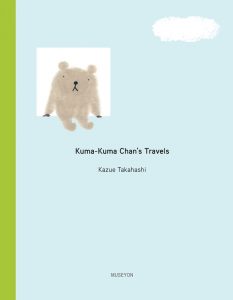
“Takahashi’s warm watercolors and relatable stories are guaranteed to entertain readers of all ages, and the latest English-language addition to this series, Kuma-Kuma Chan’s Travels, is every bit as enjoyable as its two predecessors.” (Museyon)
By Stacy Smith (Kumamoto-ken CIR, 2000-03) for JQ magazine. Stacy is a New York City–based provider of top quality Japanese interpreting, translating and writing/editing services. Starting from her initial encounter with Japan in her teens, she has built up a consummate understanding of the country‘s language and culture, enabling her to seamlessly traverse between Japan and the U.S. and serve as a bridge between the two. For more information, visit www.stacysmith.webs.com. As a writer, Stacy also shares tidbits and trends with her own observations in the periodic series WIT Life.
Having spent three years on JET in Kumamoto, home of nationwide sensation Kumamon who didn’t yet exist when I was there, I must honestly say that I approach bear characters with slight trepidation. However, I was delightfully surprised to love every minute of my encounter with Kuma-Kuma Chan, the bear who stars in the eponymous children’s book series written and illustrated by Kazue Takahashi. Her warm watercolors and relatable stories are guaranteed to entertain readers of all ages, and the latest English-language addition to this series, Kuma-Kuma Chan’s Travels, is every bit as enjoyable as its two predecessors.
The previous two books, Kuma-Kuma Chan, the Little Bear (previously reviewed in JQ here) and Kuma-Kuma Chan’s Home, looked at a day in the life of Kuma-Kuma Chan on his own and when a friend comes to visit. Kuma–Kuma Chan’s Travels is a bit more expansive, introducing readers to his world when he takes trips. I love the details at the beginning sharing what he brings with him on his journeys, along with accompanying illustrations such as a Thermos containing hot coffee. We later see him on top of a mountain drinking said coffee while watching the sunrise. These trips take place inside his head, but the descriptive text and beautiful pictures make you feel like you are with him everywhere he goes.
The series as a whole features a strong element of kawaii, or cuteness, which contributes to its Japaneseness. Also, there is an intangible sensibility to the stories that make them feel a bit different than traditional Western children’s books. In the inaugural Kuma–Kuma Chan, the Little Bear, we learn about his daily routine, which includes aspects such as eating a big salad for breakfast with lettuce from his garden and personal grooming like trimming his nails and hair. I particularly liked the scene which shows him during the winter, rolling around to catch the sunlight as the day progresses with the kerosene heater nearby. For many JET alumni, I’m sure this scene will be reminiscent of days spent in school offices where this was the sole source of heat.
For readers seeking a creature of a different nature, the Tyrannosaurus children’s books written and illustrated by Tatsuya Miyanishi is another series worth checking out. It currently features 13 titles, four of which have been published in the U.S. For those who would like to learn about these books and meet the acclaimed author, he will be at the New York and New Jersey locations of Books Kinokuniya at 2 p.m. on October 21 and 22, respectively. On both days, Miyanishi will be reading from and discussing his works, as well as signing books for those with purchased copies. For more dates in Texas, Washington and California, click here.
Kuma-Kuma Chan’s Travels is available October 1. For more information, click here.
For more JQ magazine book reviews, click here.
JQ Magazine: Nippon in New York — Bob James, Liberty City Anime Con, PLAY NYC
By JQ magazine editor Justin Tedaldi (CIR Kobe–shi, 2001-02). Justin has written about Japanese arts and entertainment for JETAA since 2005. For more of his articles, click here.
In the dog days of summer, it’s best to escape the heat in a place that’s cozy and cool. For those into Japan-related cultural events, this month offers a diverse selection of film premieres and live music—all in the comfort of indoor air conditioning.
This month’s highlights include:
Aug. 15-20, 8:00 p.m. and 10:30 p.m.
Bob James feat. special guests
Blue Note Jazz Club, 131 West Third Street
$20, $35
The career of multi-Grammy winner Bob James is long, varied and continues to evolve at every turn as he continues to captivate audiences throughout the world for more than 50 years, 58 albums, and innumerable awards. While James is recognized as one of the progenitors of smooth jazz, his music has also had a profound effect on the history of hip-hop, having been sampled frequently since the early days of the genre. A longtime star in Japan, he has recorded a piano duet album with Keiko Matsui, and worked with Seiko Matsuda as a guest vocalist on “Put Our Hearts Together,” written by James and his daughter Hilary in response to the Great East Japan Earthquake of 2011. Joining Bob and his special guests for the week’s sets are trumpeter Randy Brecker on Aug. 16.
Aug. 18-20, various times
New York Marriott Marquis, 1535 Broadway
$40-$60
The best three-day anime convention in New York City returns for its third year and features over 100 events and panels, three days of cosplay, game tournaments and anime screenings, concerts, balls and dances. This year’s special guests include Tyler Walker, Heather Walker, Chuck Huber, Aaron Roberts, Brittany Lauda, Matt Shipman, Ian Rubin, Dokudel, Michael A. Zekas, Marcus Stimac, and Reni Mimura!
Aug. 19-20, starts 10:00 a.m.
Terminal 5, 610 West 56th Street
$25
PLAY NYC is New York’s first and only dedicated games convention. The weekend will feature three floors of playable games for all consoles, PC, virtual reality and mobile devices from studios large and small and developers old and new. Games will include indie projects with some larger triple A titles. Get access to some of the biggest games coming later this year and discover many you’ve never even heard of. PLAY NYC celebrates every facet of gaming in a way that only the Big Apple can by uniting players, developers and industry pros at a games event like no other. Special guest speakers include multi-instrumentalist Zac Zinger of Japanese traditional/jazz fusion project KAI. Read More
JQ Magazine: Manga Review — ‘Kitaro and the Great Tanuki War’

“The Great Tanuki War stands apart from the other Kitaro volumes because in this adventure, the stakes are higher than anything you’ve ever seen.” (Drawn and Quarterly)
By Julio Perez Jr. (Kyoto-shi, 2011-13) for JQ magazine. A bibliophile, writer, translator, and graduate from Columbia University, Julio currently keeps the lights on by working at JTB USA while writing freelance in New York. Follow his enthusiasm for Japan, literature, and comic books on his blog and Twitter @brittlejules.
A haunted house built on an ancient burial ground? That’s minor league. How about an entire nation built above an army of human-hating yokai who command a catfish large enough to cause earthquakes?
Shigeru Mizuki’s Kitaro and The Great Tanuki War is a manga volume that tells an epic tale pitting the titular character, Kitaro, against an army of tanuki and their powerful yokai allies. There are also a few bonus stories with Kitaro’s usual one-shot adventures. You may already be familiar with Mizuki’s famous character, but if you are not, you can brush up on his origin story featured in the first volume, The Birth of Kitaro, which JQ reviewed last year here.
This marks the third volume in the English collection of Kitaro stories published by the fine folks at Drawn and Quarterly. One of our very own JET alums, Zack Davisson (Nara-ken, 2001-04; Osaka-shi, 2004-06), has been doing his part to put Shigeru Mizuki’s timeless work on the map in the English-speaking world. He has served as translator for these Kitaro stories and also for Mizuki’s colossal four-volume manga history of the Showa period. Zack is a yokai expert in his own right and you can find out more about his career and JET experience in our vintage JQ interview with him.
As many consumers of Japanese media may already be aware, yokai are strange creatures or phenomena that originate in Japan and have become widely popular globally. Kitaro is a unique yokai who solves mysteries and fights for humans. The conflict between humans and yokai is often an issue of tension for him as he straddles both sides, but this conflict takes center stage in The Great Tanuki War, when an army of tanuki escape from their underground dwelling beneath the island of Shikoku (shout-out to our Shikoku JET alums!), to wage a war on the human residents of Japan.
JQ Magazine: Philadelphia LOVEs Japan
By Therese Stephen (Iwate-ken, 1996-99) for JQ magazine.
What many people don’t know is that the City of Brotherly Love is in love with Japan, and has been since the 1876 Centennial Exhibition in Philadelphia, when the Japanese Pavilion became one of the most popular exhibits of that historic World’s Fair.
When you think of Philadelphia, you probably think of cheesesteaks, the Liberty Bell, Independence Hall or the Rocky steps at the Philadelphia Museum of Art. What you might not realize is that Philly has many ways for Japanese, and the Japanese-at-heart, to get their Japan fix for a lot less than a roundtrip ticket to Tokyo. So, whether you’re planning a quick weekend getaway or day trip this summer, or if you’re a returning Philly JET looking at your hometown with a new post-JET perspective, read on for Philly’s best Japan picks.
Let’s start with those famous Rocky steps. It’s cheesy and we know it, but everyone who visits Philly has to replay that famous Rocky Balboa moment. So once you’ve run to the top of the steps and done your obligatory fists-in-the-air-pose, head on into the Philadelphia Museum of Art (PMA) and find your way to the East Asian Galleries.
One of the most endearing and exciting things about the PMA are its period rooms. While there are plenty of rooms displaying objects on pedestals or paintings on walls, a few steps through a doorway connecting two galleries will suddenly put you in the middle of an Indian temple or the hall of a Chinese palace. Wander a little further and you’ll find Sunkaraku Tea House, the highlight of the Japanese collection in the East Asian Galleries.
WIT Life #310: The Beauty of Washi
WIT Life is a periodic series written by professional Writer/Interpreter/Translator Stacy Smith (Kumamoto-ken CIR, 2000-03). She starts her day by watching Fujisankei’s newscast in Japanese, and here she shares some of the interesting tidbits and trends along with her own observations.

One of Suzuki Sensei’s amazing works: 以花為師 (“Life lessons from flowers”). It reads from right to left, but is slightly cut off at start.
This weekend I had a chance to sit in on a culture class at the Nippon Club for the purpose of writing an article in Chopsticks. We were studying calligraphy, but specifically practicing this art on 和紙 (washi or Japanese paper). Sensei Mori Suzuki was visiting from Japan just for this class, and in addition to guest teaching we got to enjoy an exhibition of his work and other washi delights in the 7th floor gallery. Entitled 「和紙・伝統と創造」 (Washi: Dentou and Souzou or “Washi Paper: Cultural Heritage and Artistic Creativity”), this exhibit introduces the history of traditional handmade washi, the aesthetic beauty of 切金(kirikane or metallic foil cut into strips or other shapes to form decorative motifs) through the subtle light reflected from foil, origami artwork, modern washi sculptures, and Suzuki Sensei’s calligraphy creations on handmade washi. It runs through February 24 with free admission, and the gallery is open every day but Sunday so make sure to check it out before it closes !
!
JQ Magazine: Nippon in New York — ‘Your Name’ Premiere, Hougaku Quartet, ‘Girl X’
By JQ magazine editor Justin Tedaldi (CIR Kobe-shi, 2001-02). Justin has written about Japanese arts and entertainment for JETAA since 2005. For more of his articles, click here.
Stay warm this winter with some hot local events, from an exhibition that will transport you to another time and place, some new an classic anime screenings, and a mash-up multimedia performance you won’t want to miss.
This month’s highlights include:
Now through May 14
Children’s Museum of Manhattan, 212 West 83rd Street
$12 children and adults, $8 seniors
Back for the new year, this exhibit highlights how old and new traditions coexist in Japan, giving visitors a family-friendly window into Japanese culture. Children will have fun learning about life in present day Japan in this playful, immersive environment. Hello from Japan! is a new interactive exhibit in the Museum’s Lower Level Gallery. It will transport families to two distinct areas of Tokyo that exist side by side: the serene and exquisite Shinto Shrine Park, and the too-cute-for-words Kawaii Central.
Feb 7-8
City Cinemas Village East Cinema, 181-189 Second Avenue
$15
Before the release of next month’s live-action adaptation starring Scarlett Johansson and Takeshi Kitano, catch one of the greatest anime films of all time (based on the manga by Masamune Shirow and directed by Mamoru Oshii) on the big screen! In the near future, an elite group of police cyborgs called Section 9 works to stop hackers from commiting cyber crimes across the globe. However, there skills are put to the test when they come up against a hacker known as the Puppet Master. The pair of Feb. 7 screenings will be in Japanese with English subtitles; Feb. 8’s screening is English dubbed.
Thursday, Feb. 16, 8:00 p.m.
Asia Society, 725 Park Avenue
Free, tickets available here.
Re-envisioning Japanese traditional instruments for contemporary music, the Hougaku Quartet explores everything from traditional Japanese music to cutting edge new compositions, all performed on traditional instruments. The quartet is made up of a group of young virtuoso musicians who graduated from Tokyo University, who have mastered the art of creating music for today and for the future, through traditional Japanese instruments. The Hougaku Quartet carries out its mission through commission, revival performance of masterpieces composed after the 1960s, and performance in the traditional “Sankyoku” ensemble style. A group of young musicians who are committed to both sustaining and expanding tradition, Hougaku Quartet is a fresh approach to Japanese music. With a special guest performance by Ralph Samuelson.
JQ Magazine: Nippon in New York — Anime films, Final Fantasy Live, Yoshiki at Carnegie Hall
By JQ magazine editor Justin Tedaldi (CIR Kobe-shi, 2001-02). Justin has written about Japanese arts and entertainment for JETAA since 2005. For more of his articles, click here.
Start 2017 off right by heading down to your local concert hall, cinema, or arts center for some fantastic new year’s fare. Whether you enjoy movies, travel, or orchestral performances classic video games, treat yourself and catch a break from the cold.
This month’s highlights include:
Now playing through Jan. 5
IFC Center, 323 Sixth Avenue
$15
New 4K restoration! Rarely seen outside of Japan, Ocean Waves is a subtle, poignant and wonderfully detailed story of adolescence and teenage isolation. Taku and his best friend Yutaka are headed back to school for what looks like another uneventful year. But they soon find their friendship tested by the arrival of Rikako, a beautiful new transfer student from Tokyo whose attitude vacillates wildly from flirty and flippant to melancholic. When Taku joins Rikako on a trip to Tokyo, the school erupts with rumors, and the three friends are forced to come to terms with their changing relationships. As the first Studio Ghibli film directed by someone other than studio founders Hayao Miyazaki and Isao Takahata, these new screenings of Ocean Waves are paired with Ghiblies: Episode 2, a unique 25-minute short film from Studio Ghibli, featuring several comedic vignettes of studio staff as they go about their day. Utilizing new animation techniques and software that would then be deployed on the production of My Neighbors the Yamadas, Ghiblies: Episode 2 made its North American debut in December 2016. Presented in Japanese with English subtitles.
January 5 & 9, 7:00 p.m.
Princess Mononoke: 20th Anniversary
AMC Empire 25, 234 West 42nd Street
$15.99
A two-night event! Princess Mononoke, the classic animated film from groundbreaking writer/director Hayao Miyazaki and the legendary Studio Ghibli, returns to movie theaters in celebration of the beloved historical fantasy’s 20th anniversary and director Miyazaki’s birthday. The first Studio Ghibli film to receive an uncut U.S. theatrical release, Princess Mononoke returns to cinemas subtitled on Jan. 5 at 7:00 p.m. and English-dubbed on Jan. 9 at 7:00 p.m. The celebration will include a special bonus screening of the music video directed by Hayao Miyazaki, Chage and Aska’s “On Your Mark”!
Jan. 5-9
The Public: Martinson Hall, 425 Lafayette Street
$25, $20 members
Part of the 2017 Under the Radar Festival! Tokyo, 1937: An American silent film about a Japanese immigrant is introduced by a celebrated narrator whose existence is being threatened by the impending arrival of the talkies. Ten years later, he will survive under U.S. occupation as a street performer, desperately attempting to finish this story. Admiration and resistance, dreams and survival, Club Diamond is a modern take on the immigration tale. Its creators are Nikki Appino, an award-winning filmmaker, Saori Tsukada, who has been described as a “charismatic mover” (Backstage) and a “startlingly precise dancer” (The New York Times), and has been developed in collaboration with violinist Tim Fain.
JQ Magazine: Book Review — The ‘Tonoharu’ Trilogy
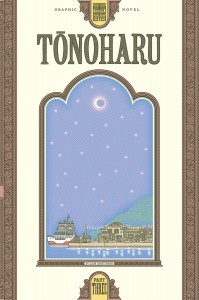
“This graphic novel series arrests your attention, from the immersive quality of the art, to the highs of self depreciating humor, to the lows of isolation and despair that run through it. Those who have lived abroad will find much to relate to.” (Top Shelf Productions)
By Julio Perez Jr. (Kyoto-shi, 2011-13) for JQ magazine. A bibliophile, writer, translator, and graduate from Columbia University, Julio currently keeps the lights on by working at JTB USA while writing freelance in New York. Follow his enthusiasm for Japan, literature, and comic books on his blog and Twitter @brittlejules.
Everyone has felt out of place at some point in their lives. People who choose to live abroad sometimes make that their everyday. In Tonoharu, cartoonist and JET alum Lars Martinson (Fukuoka-ken, 2003-2006; Kyoto-fu, 2011-2016) illustrates a story exploring themes of human relationships through the experience of an English teacher in Japan on a journey of self-discovery. Told in three parts, the final volume was released in November and represents many years of work for Martinson that began to see fruition when he received the Xeric Grant for Comic Book Self-Publishers in 2007.
Tonoharu is a tale of several non-Japanese teachers of English living in the titular rural town outside of Fukuoka City, mostly from the viewpoint of a young American named Dan Wells. Wells feels out of place in Japan, but claims to have felt the same way back home without having the excuse of being a foreigner. The reader climbs in the back seat for an intimate road trip with him through his pursuit of purpose and success in his job and social life, privy to all manner of encounters from intimacy in the bedroom to traditional parades with locally made floats. In just one year, Wells encounters unique challenges in his work, frustrations with seemingly unrequited romantic interest for another American, confusion and alarm at the mysterious activities of other foreigners in Tonoharu, and worst of all, the inability to replace light bulbs in his apartment!
Tonoharu is full of quiet moments that when described may come off as unimpressive, but they are always captivating and powerful in the way the words and imagery captures the moodiness of imperfect exchanges between people that are not usually seen in glossier fiction. This quality is enhanced by a lack of narration—the framing story of Dan’s successor (also named Dan) features his narration, but in the main story the characters only express themselves by speaking to one another. Often the things they don’t say, their expressions and their body language, and the things they choose to say while alone, speak just as powerfully as the introspective autobiographical style of narrative-driven graphic novels such as Persepolis.
JQ Magazine: Manga Review — ‘Kitaro Meets Nurarihyon’
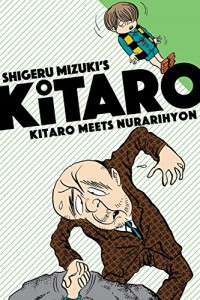
“If you are a lover of the weird or irreverent comedy mixed with supernatural horror, manga, and Japanese folklore-inspired fiction, then find the spiritual world portal of your choice to get your hands on a copy of Kitaro Meets Nurarihyon.” (Drawn and Quarterly)
By Julio Perez Jr. (Kyoto-shi, 2011-13) for JQ magazine. A bibliophile, writer, translator, and graduate from Columbia University, Julio currently keeps the lights on by working at JTB USA while writing freelance in New York. Follow his enthusiasm for Japan, literature, and comic books on his blog and Twitter @brittlejules.
Imagine coming home to find a stranger in your house. He acts like he owns the place, eats your food and drinks your beer, before leaving you reeling in confusion! Better send a letter to the Yokai Post for help from Kitaro, a charming character made by manga legend Shigeru Mizuki. Kitaro investigates strange phenomena and protects humans from ill-intentioned yokai.
Shigeru Mizuki’s Kitaro – Kitaro Meets Nurarihyon is a manga volume collecting seven more of Kitaro’s paranormal adventures. While this book can be enjoyed as a stand-alone dive into the classic character’s adventures, your enjoyment can be enhanced by checking out Kitaro’s origin story featured in the first volume, The Birth of Kitaro, reviewed last year by JQ here. This book is one of several entries in a list of literary delights from Japan that Drawn and Quarterly has been bringing to America for affordable access. This volume was also translated by JET Alum and Shigeru Mizuki expert/JQ interviewee Zack Davisson (Nara-ken, 2001-04; Osaka-shi, 2004-06).
Like it says on the tin, in this book Kitaro encounters a uniquely urban yokai: Nurarihyon. This creature takes on the appearance of an unsettling-looking and self-important man to stealthily wreak havoc as mundane as forcing you to serve him your best snacks and as extreme as explosions in cities.
Many of the yokai Kitaro encounters cause trouble because it is in their nature, some have a need to feed, or have a human-like impulse that persists beyond the grave, but Nurarihyon is cut from a different cloth. He is simply cruel and makes mischief because of his hatred for humans. He also stands apart from others in Kitaro’s rogues gallery because he finds it repulsive that Kitaro helps humans and targets him for that reason. You’ll have to pick up the book to find out just how Nurarihyon plots Kitaro’s demise, and how he very nearly gets away with it!

